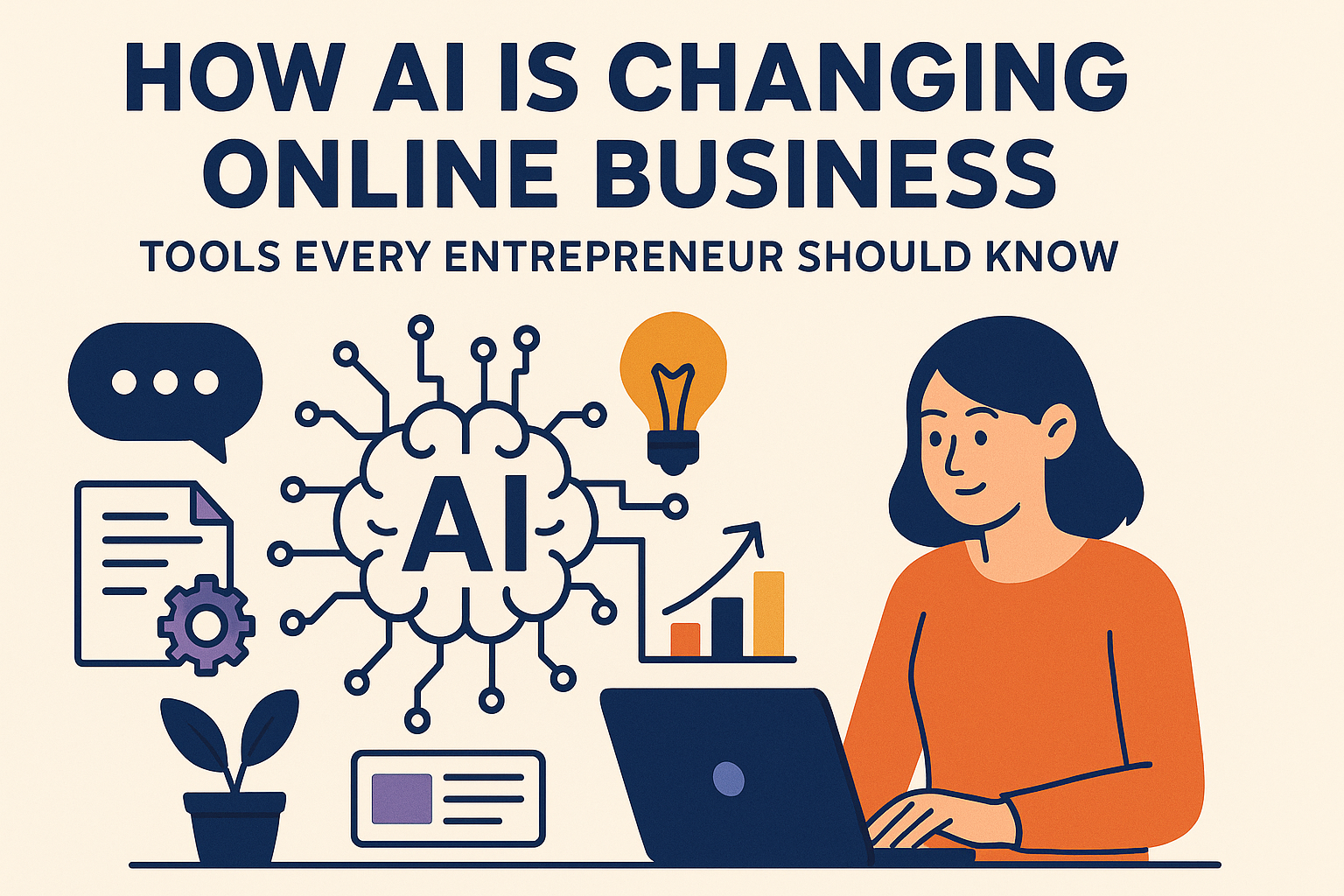The digital marketplace is no longer a level playing field; it’s an intelligence-driven arena. A seismic shift is underway, not through loud, disruptive explosions, but through the quiet, pervasive integration of Artificial Intelligence. For the modern entrepreneur, AI has transcended buzzword status to become the most critical co-pilot for growth, efficiency, and survival. A recent McKinsey Global Survey found that organizations reporting the highest adoption of AI see significantly higher revenue growth and cost reductions, with top performers being 3.5 times more likely to use AI extensively across their business functions. This isn’t a glimpse into a distant future—it’s the operational reality of 2025. This comprehensive guide will deconstruct exactly how AI is changing online business and provide a definitive toolkit of AI-powered solutions that every entrepreneur must know to not just compete, but to lead.
The AI-Powered Paradigm Shift: More Than Just Automation
The transformation brought by AI is fundamental. It moves far beyond simple automation (which follows pre-set rules) into the realm of prediction, personalization, and proactive problem-solving. AI systems can analyze vast datasets, identify patterns invisible to the human eye, and make intelligent decisions that continuously improve over time. This capability is rewriting the rules of online business across every single function.
From Reactive to Predictive: The New Business Mindset
Traditional online business models have often been reactive—analyzing last month’s sales data, responding to customer complaints, and adjusting ad spend after a campaign underperforms. AI flips this model on its head. It enables a predictive and prescriptive approach. Machine learning algorithms can forecast sales trends, predict which customers are most likely to churn, and prescribe the optimal discount to offer them to ensure they stay. This shift from looking in the rearview mirror to having a high-definition forecast of the road ahead is the single biggest competitive advantage an online business can wield today.
The Essential AI Toolbox for the Modern Entrepreneur
The AI landscape can be overwhelming. To navigate it, we’ve categorized the essential tools by business function, detailing how they solve real-world problems and which specific platforms are leading the charge in 2025.
1. AI for Marketing & Customer Acquisition
Marketing is perhaps the most AI-transformed domain, moving from spray-and-pray advertising to hyper-personalized, intent-based engagement.
- Content Creation & Ideation:
- The Problem: The incessant demand for high-quality, SEO-optimized blog posts, social media captions, ad copy, and emails is a massive drain on time and creative resources.
- The AI Solution: Advanced Large Language Models (LLMs) can now generate, refine, and repurpose content at an unprecedented scale and quality.
- Tools to Know:
- ChatGPT (OpenAI): The quintessential tool for brainstorming, drafting blog outlines, generating email sequences, and creating versatile marketing copy. Its latest iterations offer more nuanced and brand-aligned writing.
- Jasper.ai: Built specifically for marketing teams, it offers templates for everything from Facebook ads to product descriptions and integrates SEO suggestion tools like SurferSEO to ensure content ranks.
- Claude (Anthropic): Excellent for long-form content analysis and generation, known for its nuanced understanding and lower likelihood of “hallucinating” facts.
- Search Engine Optimization (SEO):
- The Problem: Google’s algorithms are increasingly sophisticated, prioritizing user intent and semantic relevance over simple keyword stuffing. Keeping up is a full-time job.
- The AI Solution: AI-powered SEO platforms analyze top-ranking content, reverse-engineer Google’s ranking factors, and provide a blueprint for creating content that is almost guaranteed to rank.
- Tools to Know:
- Frase.io: Analyzes the top Google search results for your target keyword and provides a comprehensive summary, topic cluster suggestions, and an AI-assisted content editor to help you create a more thorough and relevant article.
- MarketMuse: Uses AI to conduct a competitive content gap analysis, recommending topics to cover to make your content more authoritative than your competitors’.
- SEMrush Writing Assistant: Provides real-time SEO recommendations within your document, checking for readability, tone, and semantic keywords.
- Advertising & Paid Acquisition:
- The Problem: Manually A/B testing ad copy, images, and audience targeting is slow, expensive, and often inefficient.
- The AI Solution: Platforms use machine learning to automatically allocate budget to the best-performing ad variations and audiences in real-time, maximizing ROAS (Return on Ad Spend).
- Tools to Know:
- Google Performance Max: Allows you to provide assets (headlines, images, videos, text) and a budget, and Google’s AI automatically generates and serves the best combinations across all its properties (Search, YouTube, Display, Gmail, Discover).
- AdCreative.ai: Generates high-converting ad creatives and social media post visuals in minutes by leveraging data from high-performing ads in your niche.
- Zeta Global: Uses predictive AI to identify and target lookalike audiences that are most likely to convert, moving beyond basic demographic targeting.
2. AI for Sales & Conversion Rate Optimization (CRO)
Turning visitors into customers is the lifeblood of any online business. AI is making this process more personalized and effective than ever.
- Chatbots & Conversational AI:
- The Problem: Generic, rule-based chatbots often frustrate customers with their limited responses, failing to answer complex queries and leading to dead ends.
- The AI Solution: Modern AI chatbots use Natural Language Processing (NLP) to understand context and intent, providing human-like, helpful answers 24/7, qualifying leads, and even processing orders.
- Tools to Know:
- Intercom’s Fin: A powerful AI bot that can resolve up to 50% of customer questions without human intervention, learning from past conversations to improve its accuracy.
- Drift: Specializes in B2B lead qualification, using AI to engage website visitors, answer questions, and book meetings directly on a sales rep’s calendar.
- ManyChat: A popular tool for e-commerce brands on Facebook and Instagram, using AI to automate personalized DMs, cart abandonment sequences, and product recommendations.
- Personalization Engines:
- The Problem: Treating every website visitor the same leads to missed opportunities. Personalization at scale has been historically difficult to achieve.
- The AI Solution: AI algorithms analyze individual user behavior (pages visited, products viewed, time on site) to dynamically personalize the entire website experience in real-time.
- Tools to Know:
- Dynamic Yield (acquired by McDonald’s): Offers AI-powered personalization for product recommendations, content, and promotions, significantly boosting average order value (AOV).
- Optimizely: While known for A/B testing, its AI-powered personalization features automatically serve the best experience to different user segments without manual intervention.
3. AI for Operations & Customer Service
Streamlining backend operations is where AI delivers some of its most dramatic ROI, freeing up human capital for higher-value tasks.
- Customer Support Automation:
- The Problem: Support teams are inundated with repetitive queries about order status, returns, and basic product info, leading to long response times and agent burnout.
- The AI Solution: AI can automate ticket triaging, provide instant answers from a curated knowledge base, and even summarize support interactions for human agents to quickly resolve complex issues.
- Tools to Know:
- Zendesk Answer Bot: Integrates directly with Zendesk, using AI to automatically suggest solutions from help center articles, deflecting a significant portion of routine tickets.
- Forethought: Uses AI to understand the intent of support tickets, auto-suggests responses, and can even automate entire resolutions for common requests, cutting down handle time.
- Inventory & Supply Chain Management:
- The Problem: For e-commerce businesses, inaccurate demand forecasting leads to either dead stock (costing money) or stockouts (costing sales).
- The AI Solution: Predictive analytics models can forecast demand with high accuracy by analyzing sales history, seasonality, marketing campaigns, and even external factors like weather or social media trends.
- Tools to Know:
- Nexus (by Blue Yonder): A leader in supply chain AI, offering predictive demand forecasting and automated inventory replenishment.
- **Tools like *Cin7* and Veeqo are increasingly building AI-driven inventory forecasting directly into their omnichannel inventory management systems.
4. AI for Product Development & Strategy
AI isn’t just for marketing and ops; it’s also a powerful partner in shaping what you build and sell.
- Trend Forecasting & Market Research:
- The Problem: Identifying emerging market trends before they become mainstream is incredibly valuable but difficult to do manually.
- The AI Solution: AI tools can scrape and analyze data from social media, search engines, and e-commerce sites to identify rising consumer interests, product demands, and unmet needs.
- Tools to Know:
- Trender.ai: Analyzes search and social data to uncover emerging trends and provides insights into what audiences truly care about.
- Patternews: Uses AI to detect early signals of consumer behavior shifts and predict which trends will have longevity.
- User Experience (UX) Research:
- The Problem: Traditional user testing is slow and often limited by small sample sizes.
- The AI Solution: AI-powered platforms can record and analyze thousands of user sessions, automatically identifying friction points, rage clicks, and areas where users get confused.
- Tools to Know:
- Hotjar AI: Goes beyond heatmaps to use AI to summarize user behavior feedback and pinpoint specific UX issues that are hurting conversion rates.
- Microsoft Clarity: A free tool that uses machine learning to automatically flag sessions with high frustration, providing invaluable qualitative data at scale.
Case Study: How “Nimble Threads” Leveraged AI to 3x Revenue
The Challenge: Nimble Threads, a direct-to-consumer athletic apparel brand, was struggling with stagnant growth. Their email marketing was generic, their ad spend was inefficient, and their customer support team was overwhelmed with sizing questions, leading to a high return rate.
The AI Integration:
- Personalization: They implemented Dynamic Yield to showcase personalized product recommendations on their homepage and category pages based on a user’s browsing behavior.
- Advertising: They switched to Google Performance Max campaigns, feeding the AI with their entire product catalog and creative assets.
- Customer Service: They deployed Intercom’s Fin bot to handle common sizing and return policy queries, seamlessly escalating complex issues to human agents.
- Content: They used Jasper.ai to rapidly generate SEO-optimized blog content around topics like “Best Workout Gear for Yoga” and “How to Choose the Right Running Shorts.”
The Results (after 6 months):
- 44% increase in average order value (AOV) due to personalized upselling.
- 30% reduction in cost-per-acquisition (CPA) from Performance Max campaigns.
- 50% deflection rate on customer support queries, freeing the team to handle more complex issues.
- Tripled organic traffic from their new content hub.
- Overall, revenue grew by 3x without a proportional increase in operational costs.
This case illustrates the compound effect of integrating AI across multiple business functions—a strategy far more powerful than adopting a single tool in isolation.
Implementing AI in Your Business: A Practical Roadmap
Adopting AI can feel daunting. Follow this phased approach to ensure a smooth and successful integration.
- Identify Key Pain Points: Don’t adopt AI for AI’s sake. Start with a specific, high-impact problem. Is it high customer acquisition cost? Low conversion rates? Inefficient customer support? Start there.
- Start Small and Scale: Choose one tool to address your top priority. Run a pilot program, measure its impact meticulously, and only then consider rolling it out more broadly or adding a second tool.
- Prioritize Data Quality: AI models are only as good as the data they are fed. Ensure your customer data, product data, and performance data are clean, centralized, and accessible.
- Choose the Right Partners: Select tools that integrate easily with your existing tech stack (e.g., your CRM, email platform, e-commerce CMS). Avoid siloed solutions that create more work.
- Maintain a Human-in-the-Loop: AI excels at automation and scale, but humans excel at empathy, strategy, and creative problem-solving. Use AI to handle repetitive tasks, freeing your team to focus on high-touch customer interactions and big-picture thinking.
The Future is Now: Embracing the AI Revolution
The question for online entrepreneurs is no longer if AI will change their business, but how quickly they can adapt to harness its power. The tools outlined in this article represent the vanguard of a new era of entrepreneurship—one defined by data-driven intelligence, unprecedented efficiency, and deeply personalized customer experiences. Those who learn to leverage this new toolbox will build more resilient, adaptive, and profitable businesses. Those who delay risk being left behind, outmaneuvered by competitors who are already using AI to see farther, move faster, and serve better.
The future of online business is intelligent. It’s automated, it’s predictive, and it’s personalized. And it’s already here.
FAQ: How AI Is Changing Online Business
Q1: Isn’t AI too expensive and complex for a small business or solo entrepreneur?
A: This is a common misconception. While enterprise-level AI suites can be costly, the SaaS (Software-as-a-Service) model has democratized access. Many tools mentioned, like ChatGPT, Claude, Google Performance Max, and Microsoft Clarity, offer powerful free tiers or usage-based pricing that is accessible to businesses of all sizes. The complexity is also hidden behind user-friendly interfaces, requiring no coding knowledge to get started.
Q2: How can I ensure that my use of AI, especially in content creation, remains authentic to my brand’s voice?
A: The latest generation of AI content tools places a strong emphasis on brand voice. Platforms like Jasper allow you to train the AI on samples of your existing content (blog posts, emails) to learn and replicate your specific tone, style, and terminology. The key is to use AI as a drafting and ideation assistant, not a final publisher. Always have a human editor review, refine, and add unique anecdotes and insights that only a human can provide.
Q3: Will using AI for customer service make my business feel impersonal and robotic?
A: Quite the opposite, when implemented correctly. AI handles the repetitive, simple queries (e.g., “What’s my order status?”, “What is your return policy?”) instantly and accurately, which customers appreciate. This frees your human support agents to deal with more complex, emotionally sensitive issues where empathy and creative problem-solving are required. The result is faster resolution times for simple issues and more dedicated attention for complex ones—a win-win that enhances the overall customer experience.
Q4: What are the ethical considerations and risks of using AI in my online business?
A: Key risks include data privacy (ensuring customer data is handled responsibly), algorithmic bias (ensuring AI recommendations are fair and unbiased), and transparency. It’s crucial to:
- Choose vendors with strong data privacy and security certifications.
- Regularly audit AI-driven decisions (e.g., who is being targeted by ads) for potential bias.
- Be transparent with customers when they are interacting with an AI (e.g., “This is an AI assistant here to help…”).
- Never fully automate sensitive processes like refund approvals or disciplinary actions without human oversight.
Q5: How do I measure the ROI of implementing an AI tool in my business?
A: Always tie your AI investment back to a key performance indicator (KPI) you are trying to improve. For example:
- For an AI SEO tool: Measure the increase in organic traffic and ranking keywords.
- For an AI ad tool: Measure the decrease in cost-per-acquisition (CPA) and increase in return on ad spend (ROAS).
- For an AI support bot: Measure the ticket deflection rate and improvement in average first response time.
- For an AI personalization engine: Measure the uplift in conversion rate and average order value (AOV).
Establish a baseline for these metrics before implementation and track the delta afterward to calculate a clear ROI.








